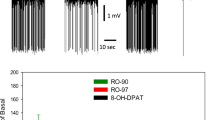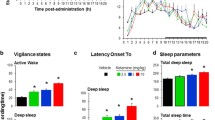Abstract
Cortical gamma rhythm is involved in transmission of information (communication) between brain areas that are believed to be involved in the pathogenesis of cognitive dysfunctions. Trace amines represent a group of endogenous biogenic amines that are known to be involved in modulation of function of classical monoamines, such as dopamine. To evaluate potential modulatory influence of a specific receptor for trace amines Trace Amine-Associated Receptor 5 (TAAR5) on the dopamine system, we used HPLC measurements of dopamine and its metabolites in the mouse striatum following administration of the putative TAAR5 agonist α-NETA. Administration of α-NETA caused significant modulation of dopaminergic system as evidenced by an altered dopamine turnover rate in the striatum. Then, to evaluate potential modulatory influence of TAAR5 on the rat brain gamma rhythm, we investigated the changes of electrocorticogram (ECoG) spectral power in the gamma-frequency range (40–50 Hz) following administration of the putative TAAR5 agonist α-NETA. In addition, we analyzed the changes of spatial synchronization of gamma oscillations of rat ECoG by multichannel recording. Significant complex changes were observed in the ECoG spectrum, including an increase in the spectral power in the ranges of delta (1 Hz), theta (7 Hz), and gamma rhythms (40–50 Hz) after the introduction of α-NETA. Furthermore, a decrease in the spatial synchronization of gamma oscillations of 40-50 Hz and its increase for theta oscillations of 7 Hz were detected after the introduction of α-NETA. In conclusion, putative TAAR5 agonist α-NETA can modulate striatal dopamine transmission and cause significant alterations of gamma rhythm of brain activity in a manner consistent with schizophrenia-related deficits described in humans and experimental animals. These observations suggest a role of TAAR5 in the modulation of cognitive functions affected in brain pathologies.






Similar content being viewed by others
References
Abi-Dargham A, Rodenhiser J, Printz D, Zea-Ponce Y, Gil R, Kegeles LS, Weiss R, Cooper TB, Mann JJ, Van Heertum RL, Gorman JM, Laruelle M (2000) Increased baseline occupancy of D2 receptors by dopamine in schizophrenia. Proc Natl Acad Sci USA 97(14):8104–8109
Aleksandrov AA, Dmitrieva ES, Volnova AB, Knyazeva VM, Gerasimov AS, Gainetdinov RR (2018a) TAAR5 receptor agonist affects sensory gating in rats. Neurosci Lett 666(14):144–147
Aleksandrov AA, Knyazeva VM, Volnova AB, Dmitrieva ES, Korenkova O, Espinoza S, Gerasimov A, Gainetdinov RR (2018b) Identification of TAAR5 agonist activity of alpha-NETA and its effect on mismatch negativity amplitude in awake rats. Neurotox Res 34(3):442–451
Benes FM, Lim B, Matzilevich D, Walsh JP, Subburaju S, Minns M (2007) Regulation of the GABA cell phenotype in hippocampus of schizophrenics and bipolars. Proc Natl Acad Sci USA 104:10164–10169
Berry MD, Gainetdinov RR, Hoener MC, Shahid M (2017) Pharmacology of human trace amine-associated receptors: therapeutic opportunities and challenges. Pharmacol Ther 180:161–180
Borowsky B, Adham N, Jones KA et al (2001) Trace amines: identification of a family of mammalian G protein-coupled receptors. Sci Proc Natl Acad USA 98:8966–8971
Burchett SA, Hicks TP (2006) The mysterious trace amines: protean neuromodulators of synaptic transmission in mammalian brain. Prog Neurobiol 79(5–6):223–246
Buzsáki G (2010) Neural syntax: cell assemblies, synapsembles, and readers. Neuron 68(3):362–385
Buzsáki G, Wang X-J (2012) Mechanisms of gamma oscillations. Annu Rev Neurosci 35:203–225
Cardin JA, Carlґen M, Meletis K, Knoblich U, Zhang F, Deisseroth K, Tsai LH, Moore CI (2009) Driving fast-spiking cells induces gamma rhythm and controls sensory responses. Nature 459(7247):663–667
Dinter J, Mühlhaus J, Jacobi SF et al (2015) 3-iodothyronamine differentially modulates α-2A-adrenergic receptor-mediated signaling. J Mol Endocrinol 54(3):205–216
Espinoza S, Salahpour A, Masri B et al (2011) Functional ineraction between trace amine associated receptor 1 (TAAR1) and dopamine D2 receptor. Mol Pharmacol 80(3):416–425
Espinoza S, Ghisi V, Emanuele M, Leo D, Sukhanov I, Sotnikova TD, Chieregatti E, Gainetdinov RR (2015) Postsynaptic D2 dopamine receptor supersensitivity in the striatum of mice lacking TAAR1. Neuropharmacology 93:308–313
Gainetdinov RR, Mohn AR, Caron MG (2001) Genetic animal models: focus on schizophrenia. Trends Neurosci 24(9):527–533
Gainetdinov RR, Hoener MC, Berry MD (2018) Trace amines and their receptors. Pharmacol Rev 70(3):549–620
Gallinat J, Winterer G, Herrmann CS, Senkowsk D (2004) Reduced oscillatory gamma-band responses in unmedicated schizophrenic patients indicate impaired frontal network processing. Clin Neurophysiol 115:1863–1874
Graham KL, Zhang JV, Lewén S et al (2014) A novel CMKLR1 small molecule antagonist suppresses CNS autoimmune inflammatory disease. PLoS ONE 9(12):e112925
Guillin O, Abi-Dargham A, Laruelle M (2007) Neurobiology of dopamine in schizophrenia. Int Rev Neurobiol 78:1–39
Halberstadt AL (1995) The phencyclidine-glutamate model of schizophrenia. Clin Neuropharmacol 18:237–249
Hebb DO (1949) The organization of behavior. Wiley, New York
Howes O, McCutcheon R, Stone J (2015) Glutamate and dopamine in schizophrenia: an update for the 21st century. J Psychopharmacol 29(2):97–115
Kanunikov IE, Lamkin PE, Belov DR (1999) Indicators of EEG spatial synchronization in schoolchildren 10–12 years old in normal and with learning difficulties. Russ J Physiol 85(3):360–371 (In Russ)
Klimash AV, Tsitseroshin MN, Shepovalnikov AN, Zajceva LG, Kondakov EN, Borovikova VN (2010) Disorders of the spatiotemporal organization of the brain’s bioelectrical activity in patients with different depressions of consciousness after severe head injury. Human Physiol 36(5):535–549
Kocsis B (2012) Differential role of NR2A and NR2B subunits in N-methyl-D-aspartate receptor antagonist-induced aberrant cortical gamma oscillations. Biol Psychiatry 71:987–995
Kolb B (1984) Functions of the frontal cortex of the rat: a comparative review. Brain Res 320(1):65–98
Kutsenko DO, Ivonin AA, Shuvaev VT, Lisyanskaya NG, Nozdrachev AD (2015) Spatial structure of EEG in depression patients with co-occurring anxiety disorders. Human Physiol 41(1):34–38
Kwon JS, O’Donnell BF, Wallenstein GV et al (1999) Gamma frequency-range abnormalities to auditory stimulation in schizophrenia. Arch Gen Psychiatry 56:1001–1005
Lam VM, Espinoza S, Gerasimov AS, Gainetdinov RR, Salahpour A (2015) In-vivo pharmacology of trace-amine associated receptor 1. Eur J Pharmacol 763:136–142
Leo D, Mus L, Espinoza S, Hoener MC, Sotnikova TD, Gainetdinov RR (2014) Taar1-mediated modulation of presynaptic dopaminergic neurotransmission: role of D2 dopamine autoreceptors. Neuropharmacology 81:283–291
Lewis DA, Hashimoto T, Volk DW (2005) Cortical inhibitory neurons and schizophrenia. Nat Rev 6(4):312–324
Liberles SD, Horowitz LF, Kuang D et al (2009) Formyl peptide receptors are candidate chemosensory receptors in the vomeronasal organ. Proc Natl Acad Sci USA 106:9842–9847
Lindemann L, Hoener MC (2005) A renaissance in trace amines inspired by a novel GPCR family. Trends Pharmacol Sci 25:274–281
Livanov MN (1973) Prostranstvennaya sinhronizaciya biopotencialov golovnogo mozga [Spatial synchronization of brain biopotentials]. Nauka, Moscow
Livanov MN, Sviderskaya NE (1984) Psychological aspects of the phenomenon of potentials spatial synchronization. Psychol J 5(5):71–83 (In Russ)
O’Donnel BF, Hetrick WP, Vohs JL, Krishnan GP, Carroll CA, Shekhar A (2004) Neural synchronization deficits to auditory stimulation in bipolar disorder. NeuroReport 15:1369–1372
Premont RT, Gainetdinov RR, Caron MG (2001) Following the trace of elusive amines. Proc Nat l Acad Sci USA 98(17):9474–9475
Preuss TM (1995) Do rats have prefrontal cortex? The rose-woolsey-akert program reconsidered. J Cogn Neurosci 7(1):1–24
Revel FG, Moreau JL, Gainetdinov RR et al (2011) TAAR1 activation modulates monoaminergic neurotransmission, preventing hyperdopaminergic and hypoglutamatergic activity. Proc Natl Acad Sci USA 108(20):8485–8490
Sakurai T, Gamo NJ, Hikida T, Kim SH, Murai T, Tomoda T, Sawa A (2015) Converging models of schizophrenia—network alterations of prefrontal cortex underlying cognitive impairments. Prog Neurobiol 134:178–201
Schin Y-W, O’Donnell BF, Youn S, Kwon JS (2011) Gamma oscillation in schizophrenia. Psychiatry Investig 8:288–296
Shepovalnikov AN, Tsitseroshin MN, Zaitseva LG, Galperina EI (2012) Features of systemic interaction of different cortex areas of the left and right brain hemispheres in different sleep stages in humans. Russ J Physiol 98(10):1228–1241 (In Russ)
Simen AA, DiLeone R, Arnsten A (2009) Primate models of schizophrenia: future possibilities. Genet Models Schizophr 179:117–125
Sohal VS, Zhang F, Yizhar O, Deisseroth K (2009) Parvalbumin neurons and gamma rhythms enhance cortical circuit performance. Nature 459:698–702
Sviderskaya NE (1987) Sinhronnaya aktivnost mozga i psihisheskie processi [Synchronous electrical activity of the brain and mental processes]. Nauka, Moscow
Uhlhaas PJ, Singer W (2006) Neural synchrony in brain disorders: relevance for cognitive dysfunctions and pathophysiology. Neuron 52(1):155–168
Uhlhaas PJ, Singer W (2010) Abnormal neural oscillations and synchrony in schizophrenia. Nat Rev Neurosci 11(2):100–113
Uylings HB, Groenewegen HJ, Kolb B (2003) Do rats have a prefrontal cortex? Behav Brain Res 146(1–2):3–17
Von der Malsburg C (1995) Binding in models of perception and brain function. Curr Opin Neurobiol 5:520–526
Wallrabenstein I, Kuklan J, Weber L et al (2013) Human trace amine-associated receptor TAAR5 can be activated by trimethylamine. PLoS ONE 8(2):e54950
Weinberger DR, Harrison PJ (2011) Schizophrenia. Wiley-Blackwell
Williams S, Boksa P (2010) Gamma oscillations and schizophrenia. J Psychiatry Neurosci 35(2):75–77
Zucchi R, Accorroni A, Chiellini G (2014) Update on 3-iodothyronamine and its neurological and metabolic actions. Front Physiol 5:402
Funding
This study was funded by the Russian Science Foundation grant N 19-75-30008
Author information
Authors and Affiliations
Corresponding author
Ethics declarations
Conflict of interest
All authors declare that they have no conflict of interest.
Ethical Approval
All applicable international, national, and/or institutional guidelines for the care and use of animals were followed.
Additional information
Publisher's Note
Springer Nature remains neutral with regard to jurisdictional claims in published maps and institutional affiliations.
Rights and permissions
About this article
Cite this article
Belov, D.R., Efimova, E.V., Fesenko, Z.S. et al. Putative Trace-Amine Associated Receptor 5 (TAAR5) Agonist α-NETA Increases Electrocorticogram Gamma-Rhythm in Freely Moving Rats. Cell Mol Neurobiol 40, 203–213 (2020). https://doi.org/10.1007/s10571-019-00716-1
Received:
Accepted:
Published:
Issue Date:
DOI: https://doi.org/10.1007/s10571-019-00716-1




